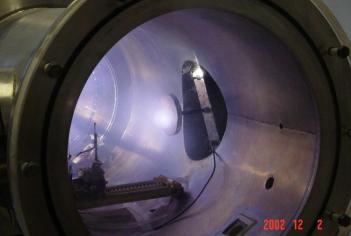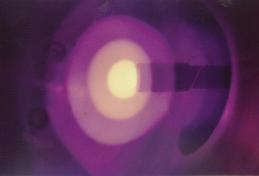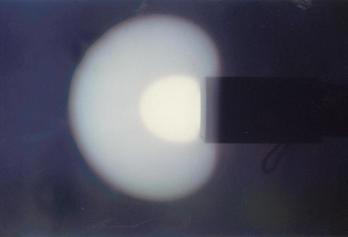Plasma double layer experiments
Double plasma layers are charge structures that develop in the plasma volume. A jump in the electric potential spatial profile connects two different plasmas and accelerates charged particles of opposite signs. This situation is represented schematically in the drawing and a real experiment with double layers is shown in the photograph.

The electrons accelerate upstream, and their collisions with neutral gas atoms release a fraction of the initial electron energy as visible light. The result is the development of bright structures within the plasma volume that are visible to the naked eye, also called fireballs in the scientific literature.

In this experiment, a metallic plate is positively polarized with respect to the ambient plasma (evidenced by the blue background glow) and in consequence an electron current is drained by this electrode. The bright plasma cloud attached to the plate develops for bias voltages exceeding a critical onset where the drained current by the plate exhibits a sudden jump. The collected current by the plate becomes greatly increased because additional charges are produced by local ionization of neutral gas atoms inside the plasma cloud attached to the plate
The double layer plasma potential jump shown in the scheme is located in the border of the bright cloud glued to the metallic plate and its thickness is very small, in the order of a fraction of millimeter. On the contrary, the bright plasma cloud is typically of 1-2 centimeters in diameter, as it can be observed in the photograph.

Since early times of Plasma Physics research, electric discharges have been employed to create in the laboratory plasmas. Glow discharges are produced by applying a high voltage between two electrodes placed into a low pressure wessel.

In spherical glow discharges with spherical symmetry, successive double layers can be produced forming a stair step plasma potential spatial profile. In the experiment of these photographs, a glow discharge was produced between the walls of a metallic plasma chamber and the inner surfaces of a cavity formed anode that is located at the extreme of the mast observed in the pictures. The electron current is focused into this electrode and each bright plasma shell corresponds to a different plasma separated by double layers. The plasma potential jumps are precisely located at the borders that separate each glowing plasma shell, where the bright changes. According to the different experimental conditions, the number of plasma shells changes always holding this hemispherical symmetry around the collecting electrode.
For further reading:
[1] C. Charles. A review of recent laboratory double layer experiments.
Plasma Sour. Sci. Technol. 16, (4) pp. R1-R25, (2007).
[2] L. Conde and L. León. Multiple double layers in a glow discharge.
Phys. Plasmas 1, pp. 2441-2447 (1994).
[3] L. Conde and L. León. Visual observation of multiple double layers.
IEEE Trans. Plasma Sci. 27, (1) pp. 80-81 (1999).